The Meizu PRO 5 Review
by Matt Humrick on June 24, 2016 8:00 AM EST- Posted in
- Smartphones
- Exynos
- Mobile
- Meizu
- Exynos 7420
Display
The PRO 5 comes with a 5.7-inch FHD (1920x1080) SAMOLED display made by Samsung, which means it uses a diamond PenTile subpixel layout. With a pixel density of just 386ppi, it will be fairly easy to notice the effects of the subpixel array if you look carefully.
We’ll measure the performance of the PRO 5’s display with an X-Rite i1Pro 2 spectrophotometer and an i1Display Pro colorimeter for brightness and contrast measurements, and we’ll use SpectraCal's CalMAN 5 software to manage the data.
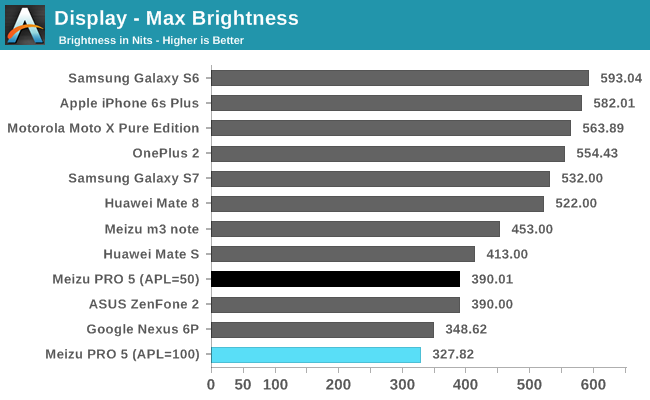
We test a display’s max brightness with a white image at 100% APL, which is more difficult for OLED displays. Except for Samsung’s Galaxy S6 and S7, which have a special overdrive mode that temporarily boosts brightness when auto-brightness is enabled, the other OLED panels in our chart struggle to break 400 nits. The Meizu PRO 5 reaches a prosaic 328 nits, a little less than the Nexus 6P and significantly less than most of the LCD displays in this chart. Reducing APL to 50% allows the PRO 5 to reach 390 nits, which is still below the 400 nit threshold I consider to be acceptable. While the PRO 5 is bright enough for most indoor situations, it becomes difficult to see the screen outdoors or when there’s bright reflections.
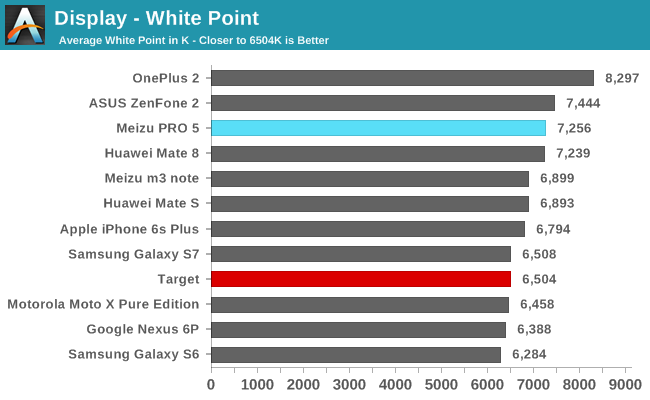
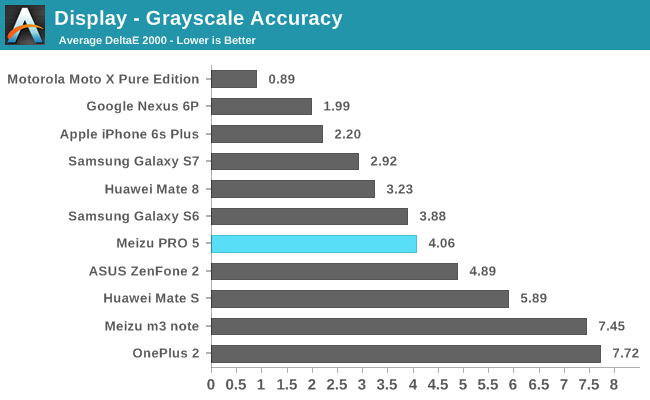
Because the PRO 5 uses an AMOLED display that can completely turn off individual pixels, it delivers a black level equal to zero. Mathematically, this gives it an infinite contrast ratio, although, in practice, reflections from the cover glass reduce the effective contrast ratio, an unavoidable issue that affects both AMOLED and IPS panels.
The PRO 5 adopts a cool white point of 7,256 K, similar to the Huawei Mate 8. This gives the display a noticeable blue tint to shades of gray and an all-white background; however, it’s not nearly as bad as the OnePlus 2 or LG G5.
Meizu’s Flyme OS does provide a slider in the settings menu to adjust the white point if the default setting is not to your liking, although the adjustment range is fairly limited. The average white point hits 7,715 K at its coldest setting and only 7,019 K at its warmest setting, which is still cooler than the ideal value and still shows a bluish-green tint on white backgrounds. It’s great that Meizu provides some level of adjustment, but it definitely needs to refine the level of control.
The cooler white point resulting from the imbalance between the blue and red primary colors hurts the PRO 5’s grayscale accuracy. Its average ΔE2000 error is far from the worst we’ve seen, but it’s still greater than 3, which is the threshold where error is noticeable but considered acceptable. The grayscale error actually remains reasonable below 50% luminance at which point the error becomes more apparent, eventually reaching a maximum error of just over 6 near 100% luminance.
The one bright spot in the PRO 5’s grayscale performance is gamma. At both 200 nits and its max brightness, gamma is equal or close to the ideal value of 2.2 and remains constant over a full luminance sweep, reducing color shifts and preserving shadow and highlight detail.
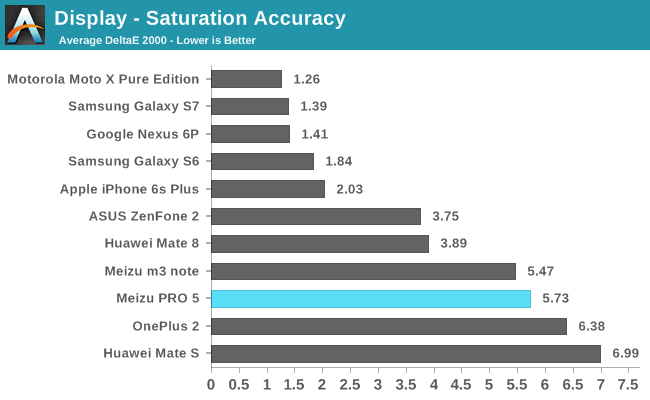
The PRO 5 uses a wide-gamut SAMOLED panel whose blue and green primary colors extend beyond the sRGB color space. Because Android does not have a color management system and the majority of content intended for computer displays uses the sRGB color space, the PRO 5’s wider color gamut only leads to inaccurate, oversaturated colors.
Looking at the saturation sweep graph, the only color that comes close to hitting all of its saturation targets is red. The other primary and secondary colors all appear oversaturated because of the PRO 5’s wider color gamut. With green and cyan, for example, a 60% saturation level is displayed as being 100% saturated in the sRGB color space. If you prefer saturated, vivid colors, this probably will not bother you. If color accuracy is important to you, however, you will be disappointed.
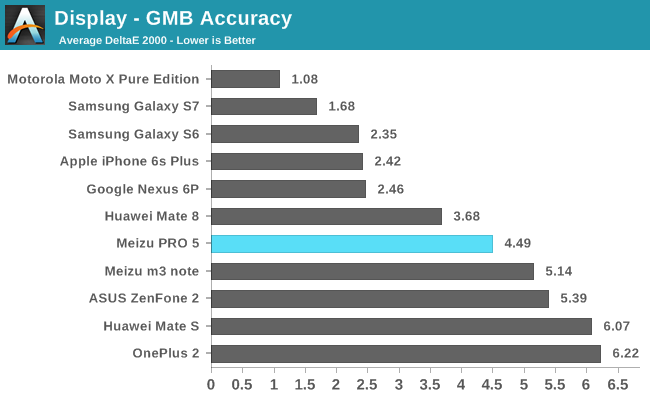
The PRO 5’s cool white point and wide gamut panel lead to mediocre color accuracy. It trails more expensive flagship devices with AMOLED panels such as the Galaxy S7 and Nexus 6P, but it also cannot match the performance of the Moto X Pure Edition’s display, a phone that is closer to the PRO 5’s price point.
The PRO 5’s display is not horrible; it does perform better than the more expensive LG G5 as well as phones closer to its own price such as the Asus ZenFone 2 or OnePlus 2. But as Meizu’s flagship device, its grayscale and color accuracy should be better. Panel brightness is also a weak point, failing to reach 400 nits even at 50% APL. Its viewing angles are excellent, however, and the display is bonded to the cover glass, reducing reflections and giving the screen a painted on look.


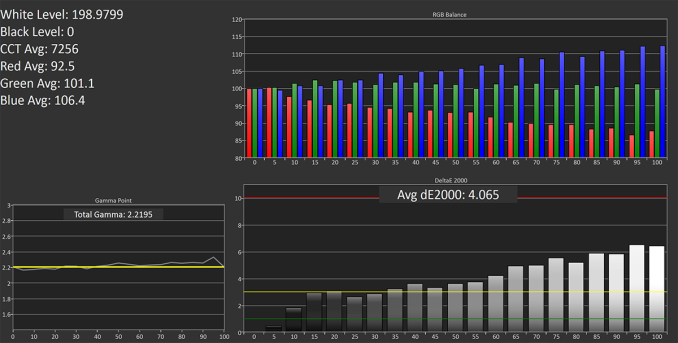

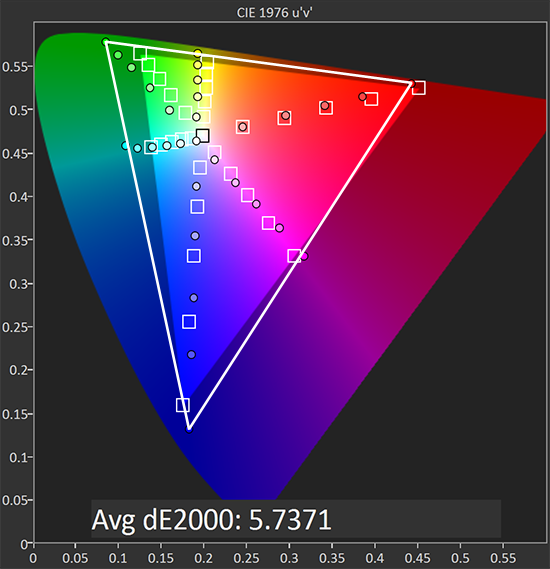
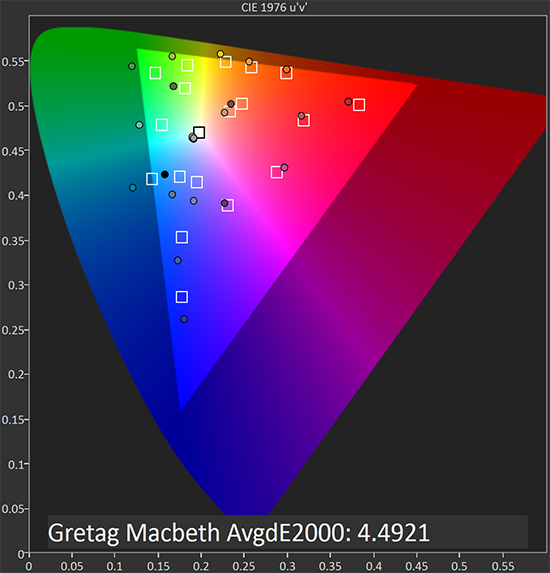









80 Comments
View All Comments
Azurael - Friday, June 24, 2016 - link
"The other four phones in this roundup all have OIS and lower resolution sensors. The Mate 8 uses a 16MP Sony IMX298 Exmor RS sensor, while the iPhone 6s Plus, Nexus 6P, and Galaxy S7 all use different 12MP Sony sensors."I had to keep going over that that to make sure I wasn't misreading. I'm fairly certain the Nexus 6P doesn't have OIS...
Matt Humrick - Friday, June 24, 2016 - link
You're right. The Nexus 6P does not have OIS. I've updated the paragraph in the review.Spectrophobic - Saturday, June 25, 2016 - link
I almost thought Anandtech will finally include audio measurements on their phone reviews...Not really a fan of subjectively describing the sound of DACs and amps.
Impulses - Saturday, June 25, 2016 - link
There's a place for both IMO, numbers will never tell the whole story when it comes to audio gear, at least not until we get a lot better at measuring things AND interpreting measurements. Review sites like Innerfidelity have proven this time and again IMO...FWIW AT did include audio measurements for a brief stint when they had some loaner gear, but they don't have access to it anymore and even if they did not every smartphone reviewer would... It's definitely something I'd love to see but the logistics seem tough to figure out.
paradox_cat - Saturday, June 25, 2016 - link
can we please have a HTC 10 review? I'd be interested particularly to see how the sound quality on that compares to this Meizu Pro 5Badelhas - Saturday, June 25, 2016 - link
I would love to read AnandTechs detailed and rigorous full review of the HTC 10 as well but I still like to see these Chinese smartphones reviews as well. Just because I can't buy them except if I import them dosent mean that are a very important part of the competitionBMNify - Saturday, June 25, 2016 - link
Thanks for the review Matt, waiting for Xiaomi Redmi Note 3 and and Mi5. Also try to get the samples for LeEco Le Max2 and LeEco Le2.We are getting all these interesting phones here in India at awesome prices and need a good English review site and you already know you have a sizable Indian readership. Besides, These companies are launching in new markets every few months, so the readership for these devices will only increase in the future.
Valantar - Saturday, June 25, 2016 - link
Another more or less baffling phone review from AnandTech. Not that it isn't slightly interesting to read about uncommon devices and new configurations of known hardware, but given that AT is still missing reviews of all current high end phones save the G5 and the latest iPhone, this is an odd one.Especially given that this device - as stated in the review - won't be very relevant outside of China due to lack of LTE support, this makes me wonder if AT is under some sort of pressure to grow their reader base in China/eastern Asia.
Sure, S7 reviews are a dime a dozen, but none with the technical knowledge and depth of AT reviews. I also get that most AT editors work part time alongside other, time-consuming engagements (like studies), but that's not really an excuse for ever-increasing lateness. If your current editors are overworked, hire more.
m0rdy - Saturday, June 25, 2016 - link
I really don't mind that anandtech's reviews are late, because they're more in depth than any other reviews. Display and colors are SO important to a smartphone, but NO ONE ELSE seems to recognise it and test it as well as Anandtech (not even the manufacturers) ! That's what keeps me coming here. I only wish that the breadth of reviews were greater (i.e. more smartphones)fuicharles - Sunday, June 26, 2016 - link
I also don't mind that anadtech review being late, given it is more in depth, but please don't be too late.